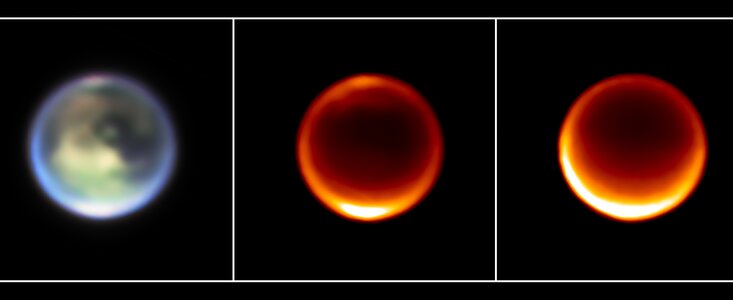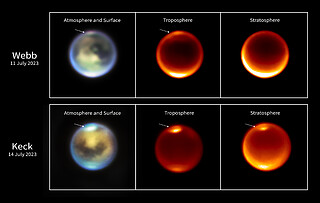weic2511 — Science Release
Webb's Titan forecast: partly cloudy with occasional methane showers
Astronomers see evidence of clouds bubbling up over Titan’s northern hemisphere.
14 May 2025
A science team has combined data from the NASA/ESA/CSA James Webb Space Telescope and the Keck II telescope to see evidence of cloud convection on Saturn’s moon Titan in the northern hemisphere for the first time. Most of Titan’s lakes and seas are located in that hemisphere, and are likely replenished by an occasional rain of methane and ethane. Webb also has detected a key carbon-containing molecule that gives insight into the chemical processes in Titan’s complex atmosphere.
Saturn’s moon Titan is an intriguing world cloaked in a yellowish, smoggy haze. Similar to Earth, the atmosphere is mostly nitrogen and has weather, including clouds and rain. Unlike Earth, whose weather is driven by evaporating and condensing water, frigid Titan has a methane (CH4) cycle. It evaporates from the surface and rises into the atmosphere, where it condenses to form methane clouds. Occasionally it falls as a chilly, oily rain onto a solid surface where water ice is hard as rocks.
“Titan is the only other place in our Solar System that has weather like Earth, in the sense that it has clouds and rainfall onto a surface,” explained lead author Conor Nixon of NASA's Goddard Space Flight Center in Greenbelt, Maryland.
The team observed Titan in November 2022 and July 2023 using both Webb and one of the twin ground-based W.M. Keck telescopes. Those observations not only showed clouds in the mid and high northern latitudes on Titan — the hemisphere where it is currently summer — but also showed those clouds apparently rising to higher altitudes over time. While previous studies have observed cloud convection at southern latitudes, this is the first time evidence for such convection has been seen in the north. This is significant because most of Titan’s lakes and seas are located in its northern hemisphere and evaporation from lakes is a major potential methane source.
On Earth the lowest layer of the atmosphere, or troposphere, extends up to an altitude of about 12 kilometers. However, on Titan, whose lower gravity allows the atmospheric layers to expand, the troposphere extends up to about 45 kilometers. Webb and Keck used different infrared filters to probe to different depths in Titan’s atmosphere, allowing astronomers to estimate the altitudes of the clouds. The science team observed clouds that appeared to move to higher altitudes over a period of days, although they were not able to directly see any precipitation occurring.
“Webb’s observations were taken at the end of Titan’s northern summer, which is a season that we were unable to observe with the Cassini-Huygens mission,” said Thomas Cornet of the European Space Agency, a co-author of the study. “Together with ground-based observations, Webb is giving us precious new insights into Titan’s atmosphere, that we hope to be able to investigate much closer-up in the future with a possible ESA mission to visit the Saturn system.”
Titan’s chemistry
Titan is an object of high astrobiological interest due to its complex organic (carbon-containing) chemistry, despite its frigid temperature of about -180 degrees Celsius. Organic molecules form the basis of all life on Earth, and studying them on a world like Titan may help scientists understand the processes that led to the origin of life on Earth.
The basic ingredient that drives much of Titan's chemistry is methane. Methane in Titan’s atmosphere gets split apart by sunlight or energetic electrons from Saturn’s magnetosphere, and then recombines with other molecules to make substances like ethane (C2H6) along with more complex carbon-bearing molecules.
Webb’s data provided a key missing piece for our understanding of the chemical processes: a definitive detection of the methyl radical CH3. This molecule (called “radical” because it has a "free" electron that is not in a chemical bond) forms when methane is broken apart. Detecting this substance means that scientists can see chemistry in action on Titan for the first time, rather than just the starting ingredients and the end products.
“For the first time we can see the chemical cake while it’s rising in the oven, instead of just the starting ingredients of flour and sugar, and then the final, iced cake,” said co-author Stefanie Milam of the Goddard Space Flight Center.
The future of Titan’s atmosphere
This hydrocarbon chemistry has long-term implications for the future of Titan. When methane is broken apart in the upper atmosphere, some of it recombines to make other molecules that eventually end up on Titan’s surface in one chemical form or another, while some hydrogen escapes from the atmosphere. As a result, methane will be depleted over time, unless there is some source to replenish it.
A similar process occurred on Mars, where water molecules were broken up and the resulting hydrogen lost to space. The result was the dry, desert planet we see today.
“On Titan, methane is a consumable. It’s possible that it is being constantly resupplied and fizzing out of the crust and interior over billions of years. If not, eventually it will all be gone and Titan will become a mostly airless world of dust and dunes,” said Nixon.
This data was taken as part of Heidi Hammel’s Guaranteed Time Observations program to study the Solar System. The results were published in the journal Nature Astronomy.
More information
Webb is the largest, most powerful telescope ever launched into space. Under an international collaboration agreement, ESA provided the telescope’s launch service, using the Ariane 5 launch vehicle. Working with partners, ESA was responsible for the development and qualification of Ariane 5 adaptations for the Webb mission and for the procurement of the launch service by Arianespace. ESA also provided the workhorse spectrograph NIRSpec and 50% of the mid-infrared instrument MIRI, which was designed and built by a consortium of nationally funded European Institutes (The MIRI European Consortium) in partnership with JPL and the University of Arizona.
Webb is an international partnership between NASA, ESA and the Canadian Space Agency (CSA).
Image Credit: NASA, ESA, CSA, STScI, Keck Observatory
Links
Contacts
Bethany Downer
ESA/Webb Chief Science Communications Officer
Email: [email protected]
ESA Newsroom and Media Relations Office
Email: [email protected]
About the Release
| Release No.: | weic2511 | |
|---|---|---|




